Menu
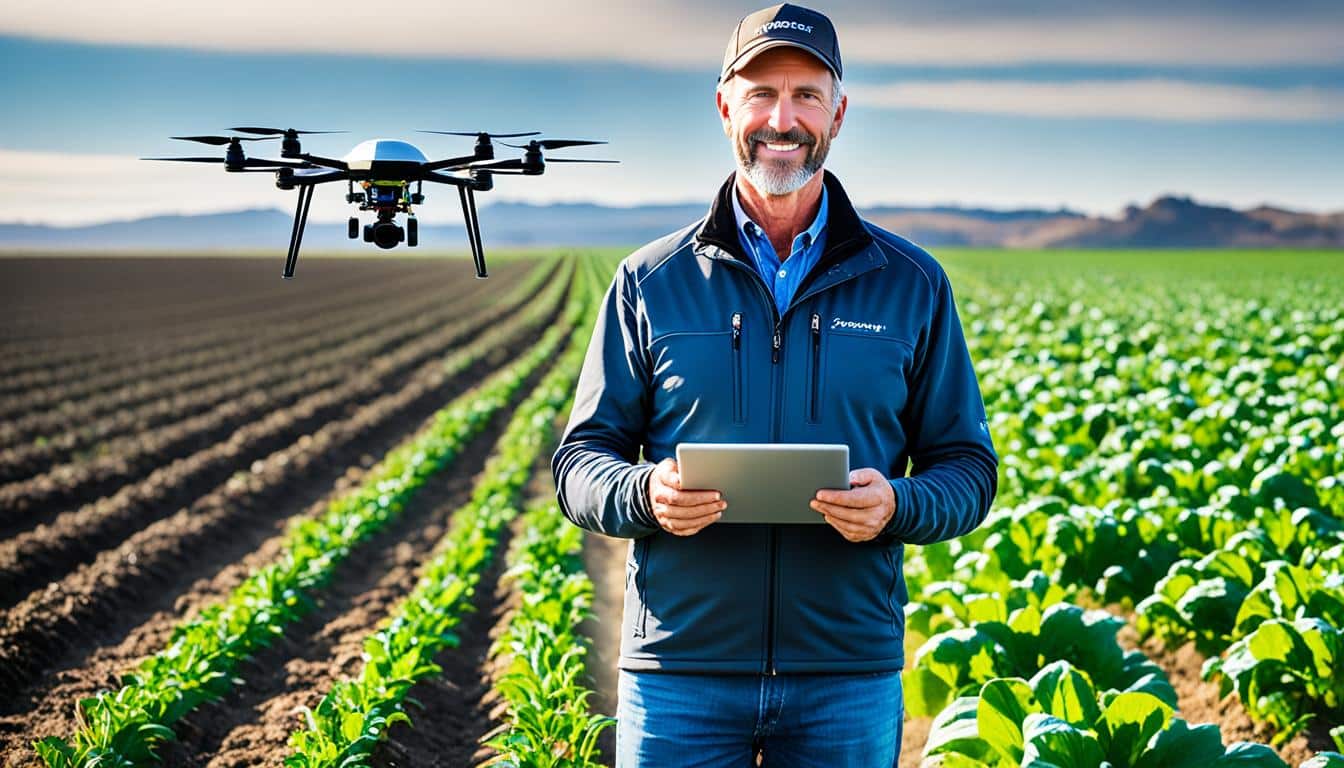
Big farms using precision farming can cut waste by almost half. This fact shows how much we can change food making through precision agriculture. It uses data and new tech to make growing food better for the planet and more profitable.
Precision crop management uses smart soil info, crop gadgets, and GPS maps. This lets farmers grow more with just the right amount of water and fertiliser. It’s key as the world’s population grows and our land and water run out. Big and small farming companies like Monsanto and John Deere are making tools for this kind of farming.
But, going the precision farming route isn’t easy. It costs a lot at the start, and some places have bad internet. Still, schools and groups like the US Department of Agriculture and NASA are working to help. They want more farmers to use these new methods. Young farmers who love tech are especially likely to give precision farming a go.
To be successful today, farmers need to know about precision agriculture. This method improves crop health and yield. It gives crops and soil exactly what they need using high tech tools.
Precision farming changes the way we farm. It uses data to make smart choices. Managing the amount of crops is key. Doing this well can earn farmers between $5000 to $10000 more per acre.
Precision farming is crucial for high crop yields and efficient resource use. Pruning shapes trees and helps them grow better. Counting buds is vital to estimate how much a crop can produce in the future.
Technology in farming includes sensors, IoT, and machine learning. They gather exact data and give useful advice. Chemical thinning in fruit trees is easy and may need less work, but sometimes hand thinning is still necessary. Using special tools can make this process even more exact.
| Method | Application Time | Labour Intensity | Tools Used |
|---|---|---|---|
| Chemical Thinning | First Month of Bloom | Lower | Sprayers |
| Hand Thinning | After Petal Fall | Higher | Equilifruit Disc, Young Apple Thinning Gauge |
Precision management makes every farm decision based on data. This leads to using resources well and getting more yield.
Precision crop management improves how we grow food, making farming more efficient. It uses various tools and methods. These help farmers work smarter and get better results from their land.
At the heart of precision farming is collecting detailed data. This is done using tools like sensors, drones, and satellites. They give farmers a close look at their crops and the soil. This up-to-the-minute data is key for smart decision-making. Machines on the ground also add to this data. They fill in the gaps from the information above.
After gathering data, powerful software processes it. This software looks at things like soil moisture and plant health. The software turns this data into helpful advice. Farmers can then fine-tune how they manage their crops. This leads to better harvests and smarter use of resources.
The software’s advice drives actions in the fields. For example, farmers can water and fertilise their fields more precisely. They use technology that adapts the amount of these inputs to what each part of the field needs. This approach cuts down on waste. It also reduces harm to the environment, making farming more sustainable.
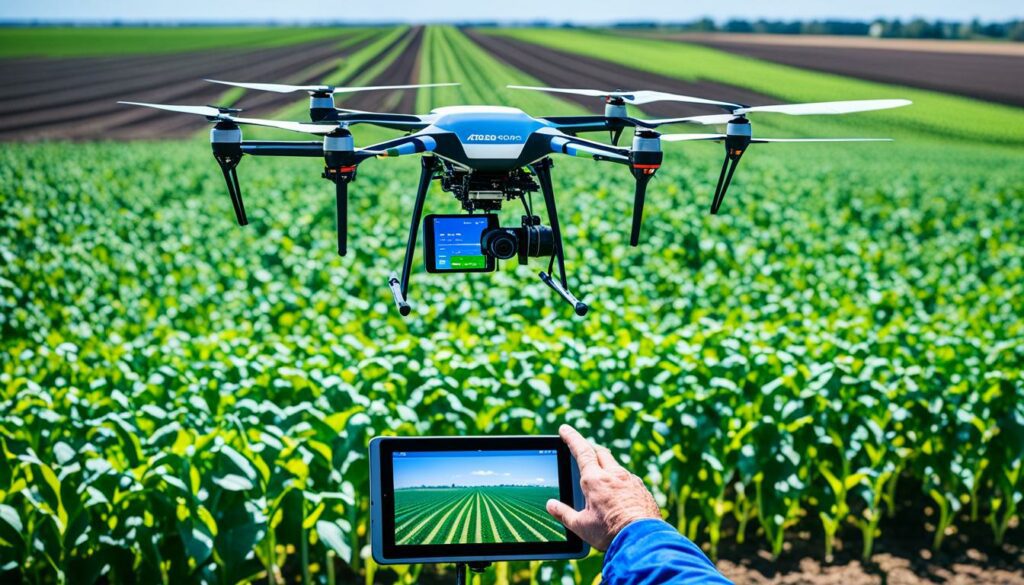
Automation plays a big role in modern agriculture. Machines like GPS-guided tractors and drone sprayers do a lot of the work. They plant and harvest with great precision. This cuts down on manual labour and makes farming tasks more accurate. As a result, the whole farming process is more efficient and productive.
Advanced agricultural technology plays a key role in upping yields. It does this by making resource use more efficient and farming more precise. By using the latest in farming gear and AI, farming is changing a lot.
Farming gear today is much better than before, making farming more efficient and precise. Tools like GPS-guided machines and auto systems help farmers work more accurately. This way,
Big companies like John Deere, Agmatix, and AGCO’s Precision Planting are leading the way in farming tech. They use data analysis and IoT to boost how well machines work. These tech upgrades help reach higher yields by making sure all resources are used well.
AI and machine learning are changing farming by offering smart insights. Farmers can make better decisions thanks to these technologies. They look at big amounts of data to give advice on managing fields:
Using AI in farming cuts down on mistakes and ups the precision. For example, AI can spot diseases or pests early. This allows farmers to act fast, saving their crops and increasing production. John Deere shows how using machine learning in farming can make a big difference.
As farming tech keeps getting better, especially in equipment and AI, it will shape the future of farming. These advancements are not just about getting more produce. They also help farm in a way that’s good for the planet, by using resources well and cutting down on harm to the environment.
In recent times, agriculture has seen big changes. Commercial and industrial activities use most of our land. This is why many farmers are now using data-driven methods. These methods help produce food in a way that does less harm to the environment. They use up-to-date information and insights from this data.
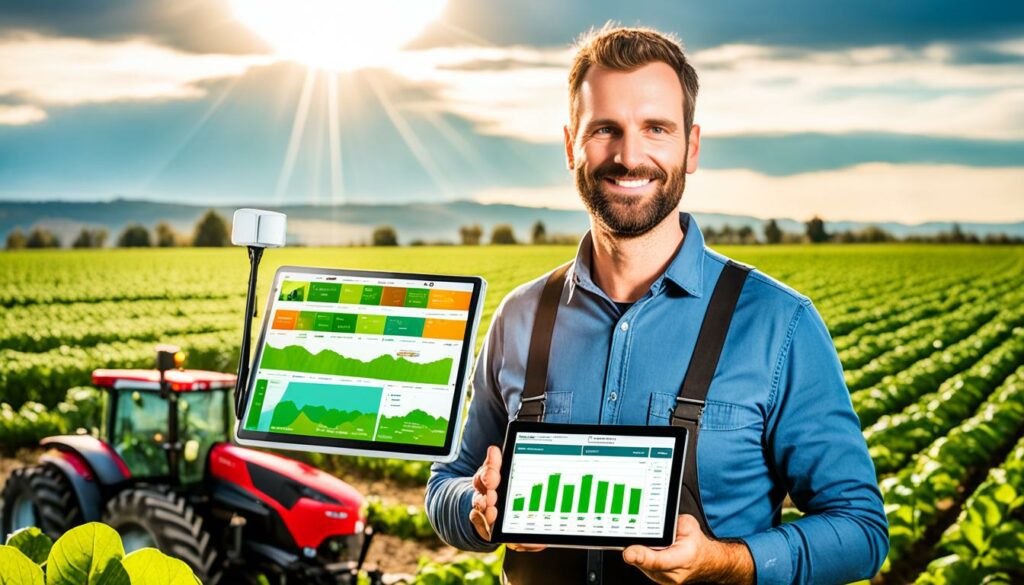
Getting real-time data is key in today’s farming. It allows farmers to quickly adjust to the changing weather and soil conditions. Geopard Agriculture is a great example. They use this data to make their crops healthier, help other plants grow, and keep the environment balanced.
Farming data insights mean using modern tech like IoT for constant checks and balances. Methods like precision agriculture focus on key factors for maximum efficiency. With tools like yield monitors and remote sensors, farmers can understand their land better. This helps them make smart decisions.
Using these modern methods, farmers can keep up with the increasing demand for food. It’s estimated that food production needs to go up by 70% by 2050. As farming continues to advance, the role of real-time data and data-based decisions is more important than ever. This is how we can farm in a sustainable and productive way.
In the fast-changing world of agriculture, smart farming is key to better productivity. It uses new tech to help farmers do more with less, cutting waste and raising crop amounts. Through IoT, GPS, and remote sensing, today’s farmers are finding smarter ways to work.
The Internet of Things (IoT) is changing how we farm. It uses sensors and data to track things like soil moisture, improving how we water our crops. This not only saves water, but it also makes our crops grow better. IoT also helps keep an eye on livestock, giving farmers data to make better choices for their animals.
GPS is crucial for making farming more detailed and efficient. It lets farmers watch over their crops closely and distribute resources accurately. Then, there’s remote sensing, which uses images from space to check on crops and find pest problems fast. By using these tools, farmers can keep their crops healthy and strong.
IoT and GPS work together to bring us important farm data for wise decisions. Add remote sensing, and we get a full picture of our farms, highlighting areas needing attention. Using all these smart tools is making farming more productive, earth-friendly, and profitable.
| Technology | Applications | Benefits |
|---|---|---|
| IoT | Livestock monitoring, intelligent data collection, irrigation management | Increased efficiency, improved decision-making, cost savings |
| GPS | Field mapping, real-time yield monitoring | Accurate resource allocation, enhanced crop monitoring |
| Remote Sensing | Crop health analysis, pest detection, field condition assessment | Precise issue identification, timely interventions, improved yield potential |
Implementing sustainable agriculture is key to using resources wisely and reducing waste. It also helps protect the environment. Precision agriculture makes farming smarter by carefully managing water, fertilisers, and pesticides. This makes the soil healthier and supports more plants and animals.
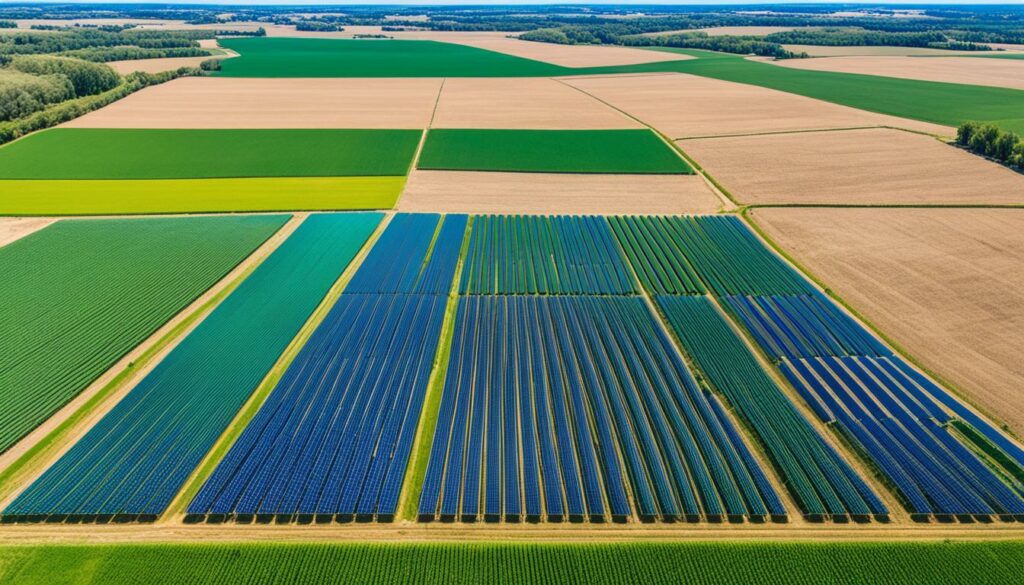
Precision farming significantly cuts down on the amount of resources needed. Using data to farm more precisely has boosted crop production by 4%. It’s also lowered the need for fossil fuels by 6%. This saving equals 100 million gallons of fossil fuel. We can also use up to 21% less water. That’s enough to fill 750,000 Olympic-size pools.
Farming more precisely has made a big difference in how we use fertilisers and chemicals. Now, we’re 7% better at putting fertilisers right where plants need them. We’ve also reduced herbicide and pesticide use by 9%. This means we’ve used 30 million pounds less of these products. Such improvements are seen in many farming tasks. For example, we use fertilisers 14% more efficiently. And, we hope to cut back herbicides and pesticides by 15% in the future. This could avoid using 48 million more pounds of these products.
Current adoption of precision agriculture technologies equates to roughly 10.1 million metric tons of CO2 emissions avoided, and with broader adoption, another 17.3 million metric tons could be avoided, making a critical contribution to slowing climate change.
Precision farming is not only good for the planet, but it also helps farmers make more money. By increasing crop yields and reducing waste, it aids in feeding the world. With the global food demand increasing, precision farming is more important than ever.
This farming method also makes the best use of our land. We haven’t needed to farm an extra 2 million acres because of it. And with full technology use, farm productivity could grow by 6%. This would mean both more food and more profitable farms.
Understanding the impact of precision agriculture highlights its role in creating a sustainable future. It optimises farming, protects nature, and cuts down on harmful effects. Precision farming sustainability is crucial for the future of agriculture, leading us towards a greener planet.
The farm world keeps changing, thanks to new precision tools. These tools are designed to make farming both better and more productive. Variable Rate Technology (VRT) and agricultural automation are at the forefront. They help manage crop inputs and work the fields smarter.
Variable Rate Technology (VRT) is key in today’s farming. It lets farmers apply different amounts of fertilisers and pesticides where needed. This saves on materials and helps the environment. Using VRT can make spreading fertiliser 180% more effective, according to recent studies. VRT is critical for meeting modern farming’s sustainability targets.
Automated tools are crucial for precision farming. This includes GPS tractors, robot pickers, and automated water systems. These machines work with great accuracy, cutting down on errors and saving on labour costs. An advanced irrigation system, when smartly controlled, can be 155% more efficient. It can also lead to crop and water savings of up to 248%. Clearly, automation is a game-changer for farming’s future.
New tools are changing the game in agriculture, making things more efficient. By using VRT and automation, farmers can do more with less. This leads to savings, better crop yields, and higher quality. Below is a table that lists the big benefits and gains from these tools:
| Technology | Efficiency Gain | Key Benefits |
|---|---|---|
| Variable Rate Technology (VRT) | 180% | Reduced wastage, optimal input use |
| Automated Machinery | 155% (smart irrigation), 248% (yield improvement) | Reduced human error, cost savings, enhanced productivity |
Advanced crop monitoring systems are changing farming. These systems use drones and satellites to check crops. Also, testing the soil is key. This helps make farming better and kinder to the environment.
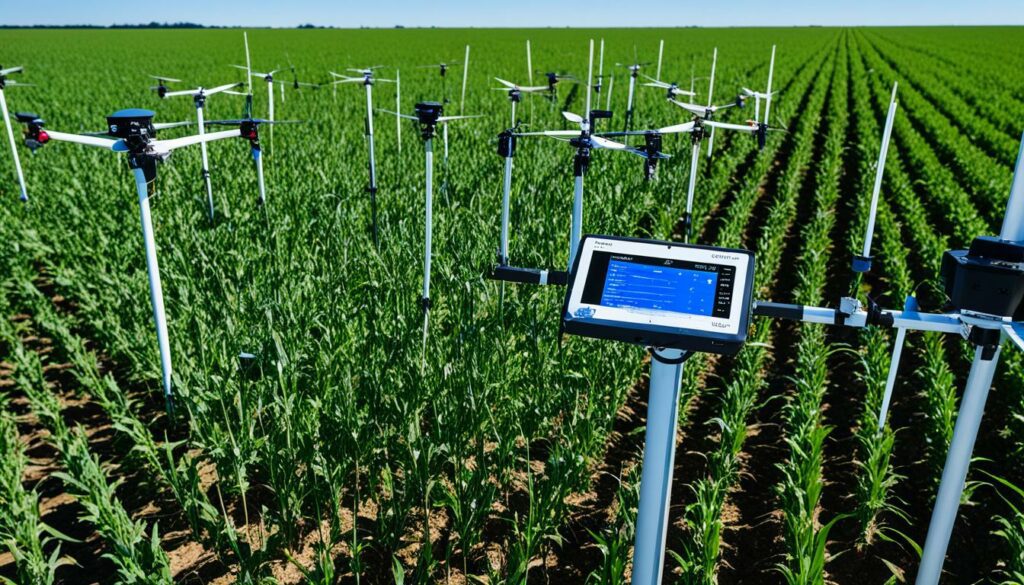
Drones are a game-changer in farming. They take high up pictures of fields. This helps spot problems early, like bugs or not enough nutrients. Using drones lets farmers see their crops’ health right away. On the other hand, satellites give a big view from space. They can watch crops over a large area every day. This helps farmers make the best choices and use resources smartly, leading to better crops.
Checking soil is a big part of these new systems. It shows the soil’s nutrients and health. Then, farmers can give exactly what their crops need, making them grow well. It also tells farmers about water in the soil. This helps use water well and not waste it. Mixing this soil information with drone and satellite views helps in making full farm plans. These plans are made for each farm’s special needs. This makes crops better and farming easier on the earth.
Remote sensing in precision agriculture is vital for growing more food. We expect the need for irrigation to double by 2050. This is because the population is growing, and we need more food. But this growth also means less water and more changes to our environment. So, using remote sensing well is very important.
Remote sensing gives farmers important information about the ground. This includes things like the type of soil, its health, and how much water’s in it. With this info, farmers can make smart choices. These choices help the crops grow better. This not only boosts the amount of food we can grow. It also keeps our ability to grow food in the future safe.
Now, we’re using smart technology like AI and IoT in farming. These work with remote sensing to help grow more food in better ways. They tell us about the water in fields and how well the crops are doing. This helps us protect the environment while feeding more people.
Precision farming with remote sensing also warns us about changes in the weather. It looks at how the oceans, land, and air are doing over time. This helps farmers plan better and get the most out of their crops.
Remote sensing does a lot. It uses pictures from space and drones to help farmers see their fields closely. This helps with spotting problems early and managing crops better. It gives a huge amount of data that changes the game for farming.
Great scientists like Paul J. Pinter Jr., Jerry L. Hatfield, and others have done a lot of work in this field. Their research shows how important remote sensing is for farming. You can find their studies at DigitalCommons@University of Nebraska – Lincoln.
In the end, using remote sensing in farming is more than just a new tech. It’s crucial for farming in a way that’s both good for the planet and for people.
The future of precision farming looks bright with new agricultural ideas. These new methods aim to change how we farm. They are not just about producing more. They also bring benefits that last a long time for farmers.
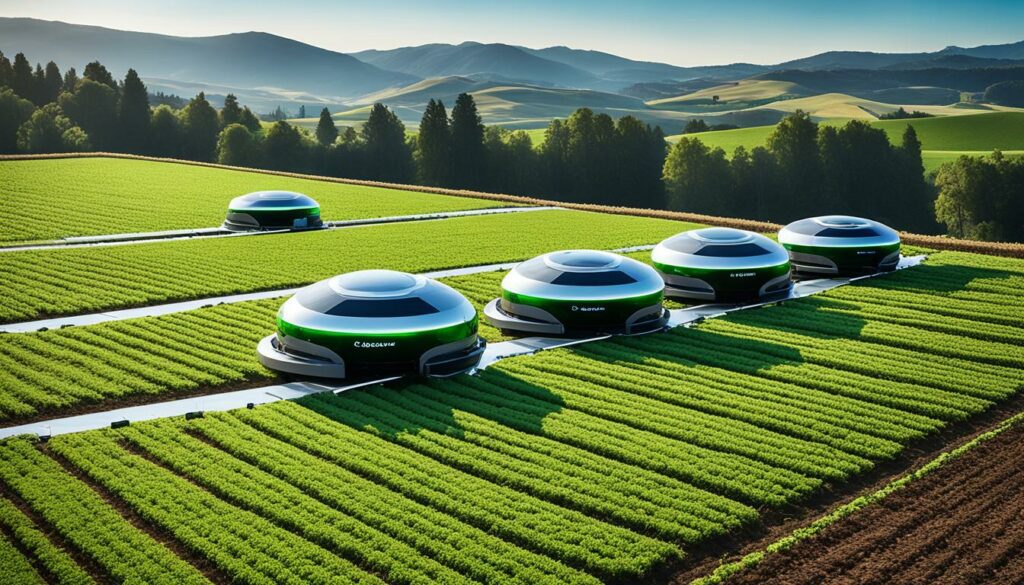
The use of AI in farm robots is among the thrilling new chapters. These robots can do weed, sow seeds, and harvest better than before. They work alongside smart models that help farmers make better choices. This improves how they use their resources. Technologies like remote sensing, GPS, and cloud data are already part of farming. They are preparing us for even more advanced tools in the future.
Enhanced farming not only raises productivity but does much more. It helps use fewer chemicals and keeps the soil healthy. This makes our food-growing practices better for nature. It’s important because 86% of animals at risk of extinction face threats from farming. Adding onto this, automation makes farming easier and cheaper. The use of software keeps important farm data safe and checks the environment constantly. This leads to quick actions that save crops. The market for advanced farming tools is growing fast, showing a bright future ahead. It will help farmers worldwide be ready for any changes in the environment.
| Innovation | Function | Benefits |
|---|---|---|
| AI-driven farm bots | Weeding, Seeding, Harvesting | Increased Accuracy |
| Advanced Prediction Models | Data Analysis, Resource Optimisation | Informed Decision-Making |
| Automation Features | Streamlined Operations, Labour Reduction | Cost Savings, Efficiency |
| Crop Management Software | Real-Time Data Access, Remote Sensing | Sustainable Practices, Risk Mitigation |
To sum up, precision farming’s future is very promising. It includes big tech improvements and a big move towards keeping our environment safe. With these new tools, farmers can expect better harvests. They can also save resources and make farming systems stronger.
Precision agriculture has many benefits but faces several challenges. In 2023, only 27 percent of U.S. farms used these practices. This shows the big hurdles that still need to be tackled.
Technical challenges are a big issue. Connecting and using high-tech tools is hard. There are many different precision agriculture tools but no single set of rules for using them.
Data sharing problems and who owns the information also make things difficult. They stop people from investing in these technologies.
Money is a big problem in precision agriculture. Advanced tools are expensive. Many farmers can’t afford them without seeing a quick return on their money. This can slow down progress.
To help with these money challenges, things like financial help and more research could make a big difference. These steps could encourage more farmers to use precision agriculture.
The table below highlights these points:
| Challenge | Description |
|---|---|
| Up-Front Costs | High initial costs of equipment and software. |
| Data Sharing Issues | Concerns over data privacy and ownership. |
| Lack of Standards | No uniform standards for technology integration. |
| Connectivity Issues | Reliable internet and network access is often required. |
It’s crucial to take on these challenges to make precision farming more common. Policy changes and more research can improve efficiency and care for the environment.
Analyzing precision crop management case studies shows how they make a difference in agriculture. The GramworkX – Kisan App is a great example. In its first month, over 500 farmers signed up. More than 30% of these users added detailed crop information to their zones. This quick acceptance shows the immediate value and trust in these tech tools.
The app highlighted interesting farming methods. For example, 48% used drip irrigation, and 33% used flood irrigation. It also covered over 20 types of crops. Tomatoes were the most planted, then Chilli, Cotton, and Groundnut. This variety shows how precision farming benefits many types of farms. It makes using resources smarter and increases how much you grow.
Looking at specific crops, like Cotton, gives us eye-opening data. For Cotton, the water needs were very different, by up to 28K litres, depending on the stage and region. Using precision irrigation, the app adjusted the water each field needed every day. Tomato growing showed similar results. The wind also affected how much water plants needed. This shows that precision farming adjusts to what crops really need based on various conditions.
These studies outline the big picture of precision crop management. They show how using tech can really help farmers. It boosts harvests and protects the environment too. This success is a big deal in agriculture.
Precision crop management uses data and technology to get the most from farms. It helps increase crop numbers, saves resources, and makes farming greener. By looking at data, farmers can use resources better and protect the environment.
It’s key to meeting the food needs of a growing world and protecting our planet. By giving exactly what crops and soil need, it boosts health and outputs. This means more food while using resources well.
In precision farming, we use sensors, drones, and more. These tools give farmers clear data and smart directions. This helps them make the best choices for their fields.
We collect data using things like sensors, drones, and satellites. These tools tell us a lot about the fields. They help farmers make the right moves for their crops.
AI and machine learning are important for sorting through lots of farming data. They find ways to make farming more precise, like using the right amount of water and predicting issues. This means smarter farming choices.
IoT helps keep track of farming and makes it better in real time. Meanwhile, GPS and satellite tools check fields exactly. This system means farmers can stay ahead and manage their farms well.
Precision farming saves water, fertilisers, and pesticides, doing less harm. It also helps keep the soil and nature healthy. This leads to farming that lasts for the long term.
Important tools are VRT and machines that work by themselves. VRT changes the amount of inputs to be more efficient. Self-working devices do jobs perfectly, like planting.
Systems that watch crops from above help spot problems early. This makes it possible to find the best ways to treat fields. As a result, crops do better and yield more food.
Tools like satellite photos and drone flights give farmers lots of info about their crops. This helps them solve problems fast and make good choices. Farming becomes more productive this way.
The future will bring AI farming bots and new ways to predict what will happen. These changes will mean more crops, saving resources, and being ready for nature’s changes. They could really change farming for the better.
Getting good internet and easy-to-use tech is hard for precision farming. Plus, it can cost a lot of money to get started. Farmers need to really check if the benefits are worth the cost.
There are many stories of farms doing well with precision farming. They’ve seen big jumps in crop numbers, use resources better, and care for the planet. These farms are all over the world.